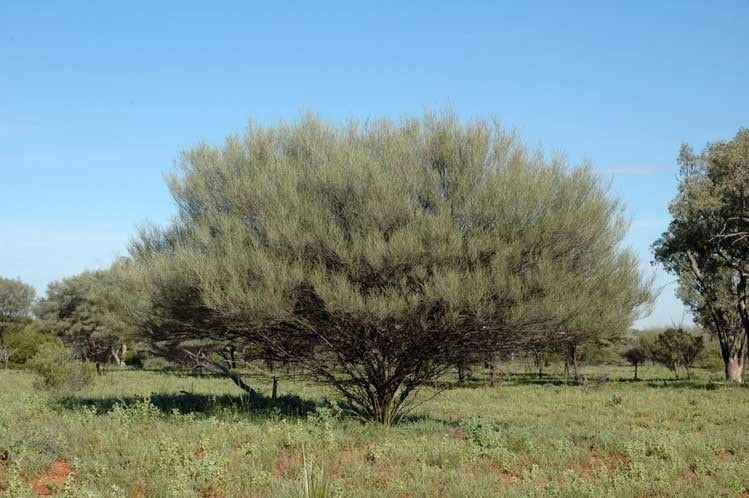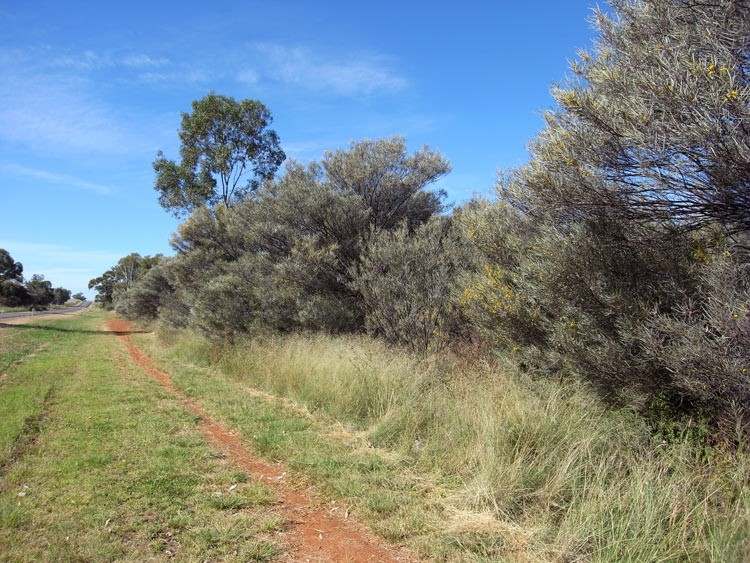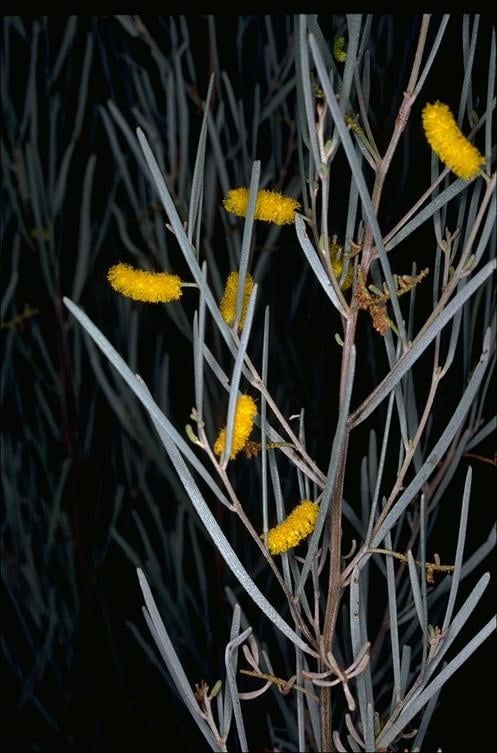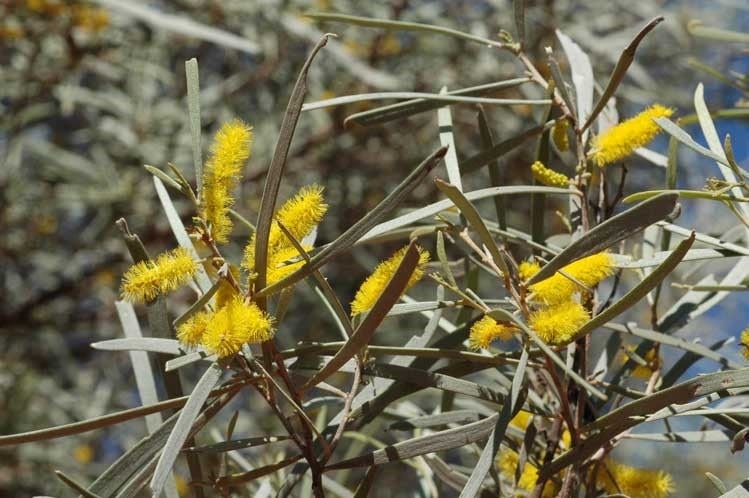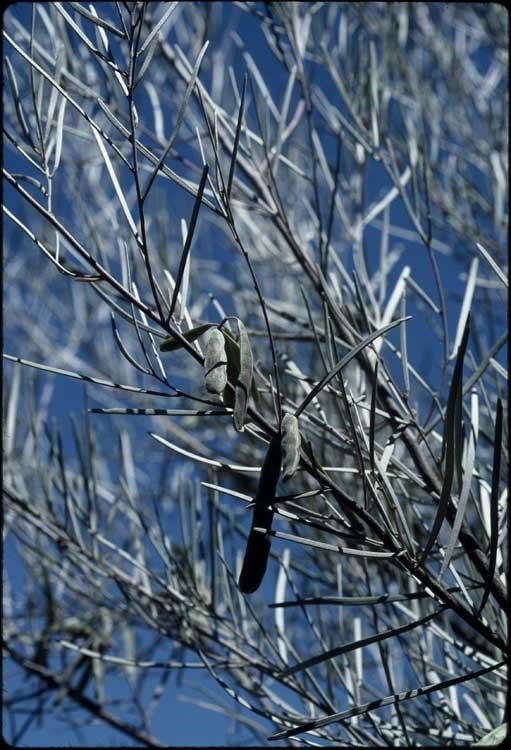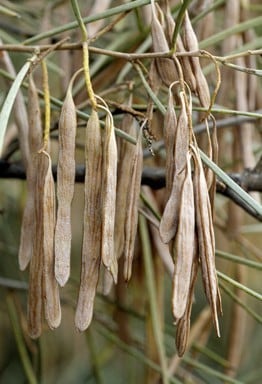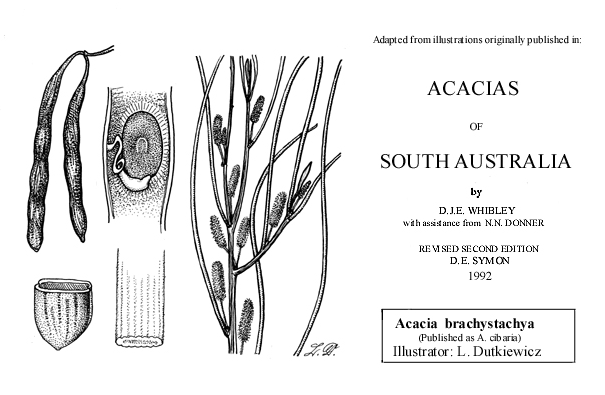Acacia brachystachya Benth.
WATTLE
Acacias of Australia
Common Name
Umbrella Mulga, Umbrella Wattle, Turpentine Mulga
Family
Fabaceae
Distribution
Occurring in all mainland States except Vic., from the extreme east of W.A., the south of N.T., much of S.A. to south-western Qld and north-eastern N.S.W.
Description
Shrub branched at base, to 5 m tall and wide. Branchlets with dense appressed hairs between dark resinous ribs; some red-glandular hairs on new growth. Phyllodes flat, occasionally subterete, straight, 4–11 cm (rarely to 18 cm) long, 1–3 mm wide, finely striate, appressed-pubescent between longitudinal nerves. Inflorescences single in axils; peduncles (2–) 3–10 mm long; spikes 10–30 mm long. Flowers 5-merous; sepals oblong, 0.5–0.8 mm (rarely to 1 mm) long, united in tube to 0.4 mm long or occasionally free, with long hyaline hairs on lobes; corolla 1.5–1.8 mm (rarely to 2 mm) long, pubescent to varying degrees; stamens to 3 mm long; ovary with dense ±appressed longish white hairs. Pods not stipitate, narrowly oblong in outline, straight, turgid, oval in section, to 7.5 cm long, 4–8 mm wide, dull brown with prominent yellowish resinous anastomosing longitudinal nerves, elsewhere appressed-pubescent, tardily dehiscent. Seeds longitudinal, oblong, 5–8 mm long, 3–5 mm wide; aril small, terminal, pileate, pale.
Habitat
Often on sandy loam soils in association with A. aneura and on sandy soils between dunes or on degraded dunes. In the eastern part of its range it also occurs on shallow stony soils. Its ecological requirements are similar to those of A. ramulosa but it has a narrower geographic range.
Specimens
W.A.: Reid, June 1959, E.McCrumm s.n. (PERTH). N.T.: Rainbow Valley, D.E.Albrecht (BRI, DNA, MEL). S.A.: Tarcoola, J.A.Mattner 50 (AD) & 21 Sept. 1920, E.H.Ising s.n. (AD); Stuart Hwy adjacent to Agnes Creek HS, B.Hadlow 271 & A.B.Court (CANB, NSW). Qld: 'Nerrigundah', W slope of Grey Ra., 60 km SW of Quilpy, L.Pedley 4203 (BRI). N.S.W.: White Cliffs road, P.E.Conrick 1471 (AD, MEL, PERTH).
Notes
Randell (J. Adelaide Bot. Gard. 14: 128 (1992)) discussed the usage of the name Acacia brachystachya from that of Mueller, in Tate (Trans. & Proc. Roy. Soc. S. Australia 5: 82–86 (1882)), through Maiden to Maslin (J. Adelaide Bot. Gard. 2: 306–307 (1980)). She considered that the type specimen could not be confidently identified, mainly because it lacks pods, and consequently she treated the name as a nomen dubium. She took up the name A. cibaria F. Muell. for the species, lectotypifying it (quite correctly) more exactly than I had done previously (see Austrobaileya 1: 131 (1978)). Now that I have seen specimens of A. ramulosa from throughout its range, I agree with both Randell (J. Adelaide Bot. Gard. 14: 128 (1992)) and Maslin (J. Adelaide Bot. Gard. 2: 306–307 (1980)) that both lectoparatypes of A. cibaria are A. ramulosa; the syntype specimen with large seeds is representative of the species in the vicinity of Shark Bay. Evidently the vernacular name ‘wanyu’ attributed to it is not always associated with A. wanyu Tindale. The specimen chosen as lectotype of A. brachystachya by Randell, which I consider an isotype (Pedley, Austrobaileya 1: 131 (1978)), is as described by her: ‘a leafy specimen with very young flowers, and without fruit’. The holotype (K) is also fragmentary and lacks fruit. Despite the rather unsatisfactory nature of the type material, it can be identified. Though the flowers are young, the corolla is discernibly pubescent with moderately dense short appressed hairs. Previous workers, Bentham included, seem to have overlooked the significance of the indumentum of the flowers, if indeed, they noted it at all. Since the corolla of A. aneura is glabrous or occasionally, usually in W.A., with only a few hairs, and the hairs of the corolla of A. ramulosa are longer and looser, A. brachystachya can be distinguished from the only species with which it is likely to be confused, even when no pods are present. The name A. brachystachya is therefore reinstated with A. cibaria as a synonym.
Specimens usually referred to A. brachystachya in the west of W.A. are for the most part, hybrids between A. aneura and A. ramulosa.
The closest relative of A. brachystachya is A. ramulosa from which the former differs in its smaller pods which are oval in cross-section, its smaller flowers with petals with less dense and usually shorter hairs, and its usually narrower phyllodes.
FOA Reference
Data derived from Flora of Australia Volumes 11A (2001), 11B (2001) and 12 (1998), products of ABRS, ©Commonwealth of Australia
Author
L.Pedley
Minor edits by B.R.Maslin & J.Rogers
This identification key and fact sheets are available as a mobile application:
URL: https://apps.lucidcentral.org/wattle/
© Copyright 2018. All rights reserved.
